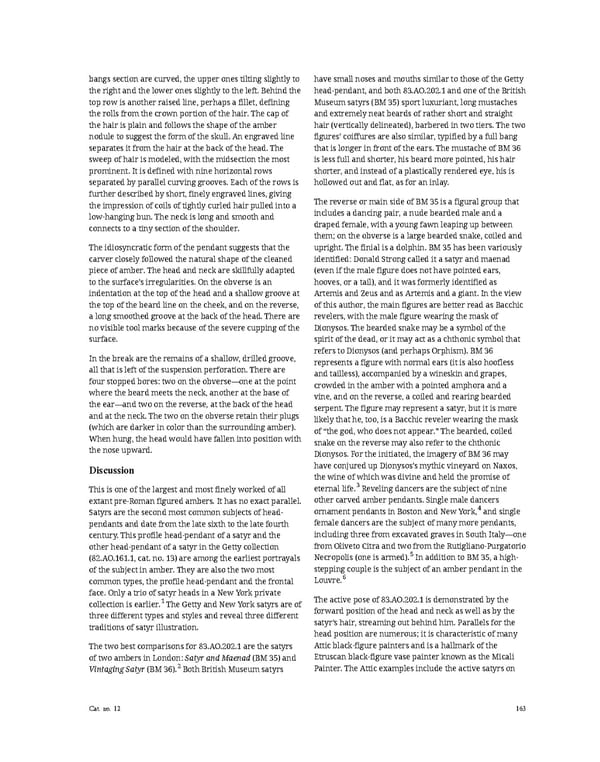bangs section are curved, the upper ones tilting slightly to have small noses and mouths similar to those of the Getty the right and the lower ones slightly to the left. Behind the head-pendant, and both 83.AO.202.1 and one of the British top row is another raised line, perhaps a fillet, defining Museum satyrs (BM 35) sport luxuriant, long mustaches the rolls from the crown portion of the hair. The cap of and extremely neat beards of rather short and straight the hair is plain and follows the shape of the amber hair (vertically delineated), barbered in two tiers. The two nodule to suggest the form of the skull. An engraved line figures’ coiffures are also similar, typified by a full bang separates it from the hair at the back of the head. The that is longer in front of the ears. The mustache of BM 36 sweep of hair is modeled, with the midsection the most is less full and shorter, his beard more pointed, his hair prominent. It is defined with nine horizontal rows shorter, and instead of a plastically rendered eye, his is separated by parallel curving grooves. Each of the rows is hollowed out and flat, as for an inlay. further described by short, finely engraved lines, giving the impression of coils of tightly curled hair pulled into a The reverse or main side of BM 35 is a figural group that low-hanging bun. The neck is long and smooth and includes a dancing pair, a nude bearded male and a connects to a tiny section of the shoulder. draped female, with a young fawn leaping up between them; on the obverse is a large bearded snake, coiled and The idiosyncratic form of the pendant suggests that the upright. The finial is a dolphin. BM 35 has been variously carver closely followed the natural shape of the cleaned identified: Donald Strong called it a satyr and maenad piece of amber. The head and neck are skillfully adapted (even if the male figure does not have pointed ears, to the surface’s irregularities. On the obverse is an hooves, or a tail), and it was formerly identified as indentation at the top of the head and a shallow groove at Artemis and Zeus and as Artemis and a giant. In the view the top of the beard line on the cheek, and on the reverse, of this author, the main figures are better read as Bacchic a long smoothed groove at the back of the head. There are revelers, with the male figure wearing the mask of no visible tool marks because of the severe cupping of the Dionysos. The bearded snake may be a symbol of the surface. spirit of the dead, or it may act as a chthonic symbol that refers to Dionysos (and perhaps Orphism). BM 36 In the break are the remains of a shallow, drilled groove, represents a figure with normal ears (it is also hoofless all that is left of the suspension perforation. There are and tailless), accompanied by a wineskin and grapes, four stopped bores: two on the obverse—one at the point crowded in the amber with a pointed amphora and a where the beard meets the neck, another at the base of vine, and on the reverse, a coiled and rearing bearded the ear—and two on the reverse, at the back of the head serpent. The figure may represent a satyr, but it is more and at the neck. The two on the obverse retain their plugs likely that he, too, is a Bacchic reveler wearing the mask (which are darker in color than the surrounding amber). of “the god, who does not appear.” The bearded, coiled When hung, the head would have fallen into position with snake on the reverse may also refer to the chthonic the nose upward. Dionysos. For the initiated, the imagery of BM 36 may Discussion have conjured up Dionysos’s mythic vineyard on Naxos, the wine of which was divine and held the promise of This is one of the largest and most finely worked of all eternal life.3 Reveling dancers are the subject of nine extant pre-Roman figured ambers. It has no exact parallel. other carved amber pendants. Single male dancers Satyrs are the second most common subjects of head- ornament pendants in Boston and New York,4and single pendants and date from the late sixth to the late fourth female dancers are the subject of many more pendants, century. This profile head-pendant of a satyr and the including three from excavated graves in South Italy—one other head-pendant of a satyr in the Getty collection from Oliveto Citra and two from the Rutigliano-Purgatorio (82.AO.161.1, cat. no. 13) are among the earliest portrayals Necropolis (one is armed).5 In addition to BM 35, a high- of the subject in amber. They are also the two most stepping couple is the subject of an amber pendant in the common types, the profile head-pendant and the frontal Louvre.6 face. Only a trio of satyr heads in a New York private The active pose of 83.AO.202.1 is demonstrated by the collection is earlier.1 The Getty and New York satyrs are of three different types and styles and reveal three different forward position of the head and neck as well as by the traditions of satyr illustration. satyr’s hair, streaming out behind him. Parallels for the head position are numerous; it is characteristic of many The two best comparisons for 83.AO.202.1 are the satyrs Attic black-figure painters and is a hallmark of the of two ambers in London: Satyr and Maenad (BM 35) and Etruscan black-figure vase painter known as the Micali Vintaging Satyr (BM 36).2 Both British Museum satyrs Painter. The Attic examples include the active satyrs on Cat. no. 12 163
 Ancient Carved Ambers in the J. Paul Getty Museum Page 172 Page 174
Ancient Carved Ambers in the J. Paul Getty Museum Page 172 Page 174